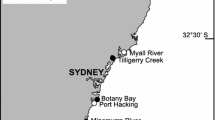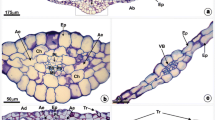Abstract
Seagrasses need to withstand hydrodynamic forces; therefore, mechanical properties such as flexibility or breaking resistance are beneficial for survival. The co-variation of leaf breaking properties with biochemical traits in seagrasses has been documented, but it is unknown if the same patterns apply to leaf flexural properties. To interpret changes in the ecological function of seagrass ecosystems based on acclimation responses to environmental changes, it is necessary to understand the factors that affect flexural leaf properties. Here, morphological and flexural leaf properties of the perennial type of Zostera marina across different environmental conditions along European Atlantic climate regions are presented together with C:N ratio and neutral detergent fibre content as descriptors of biochemical leaf composition. Eelgrass leaves from cold regions were ~ threefold more elastic and ~ tenfold more flexible, were also narrower (1.7-fold), and contained ~ 1.9-fold higher fibre content than from plants growing in warmer regions. Eelgrass also showed acclimation to local conditions such as seasonality, water depth, and hydrodynamic exposure. Leaves collected from exposed or shallower locations or during winter were more flexible, suggesting an avoidance strategy to hydrodynamic forcing, which is generally higher under those conditions. Flexural rigidity was almost equally controlled by bending modulus (35%) and leaf thickness (37%), indicating functional differences compared to leaf breaking described in the literature. Overall, the findings indicate that Zostera marina has a high flexural plasticity and high acclimation capacity to some climate change effects such as sea level rise and increase in storm frequency and intensity.





Similar content being viewed by others
References
Beck HE, Zimmermann NE, McVicar TR, Vergopolan N, Berg A, Wood EF (2018) Present and future Köppen-Geiger climate classification maps at 1-km resolution. Scientific Data 5:180214 EP
Bouma TJ, de Vries MB, Low E, Peralta G, Tánczos IC, van de Koppel J, Herman PMJ (2005) Trade-offs related to ecosystem engineering: a case study on stiffness of emerging macrophytes. Ecology 86(8):2187–2199
Burgert I, Fratzl P (2009) Plants control the properties and actuation of their organs through the orientation of cellulose fibrils in their cell walls. Integr Comp Biol 49(1):69–79
de los Santos CB, Brun FG, Onoda Y, Cambridge ML, Bouma TJ, Vergara JJ, Pérez-Lloréns JL (2012) Leaf-fracture properties correlated with nutritional traits in nine Australian seagrass species: Implications for susceptibility to herbivory. Mar Ecol Prog Ser 458:89–102
de los Santos CB, Brun FG, Vergara JJ, Pérez-Lloréns JL (2013) New aspect in seagrass acclimation: Leaf mechanical properties vary spatially and seasonally in the temperate species Cymodocea nodosa Ucria (Ascherson). Mar Biol 160(5):1083–1093
de los Santos CB, Onoda Y, Vergara JJ, Pérez-Lloréns JL, Bouma TJ, La Nafie YA, Cambridge ML, Brun FG, Bouma TJ, La Nafie YA, Cambridge ML, Brun FG (2016a) A comprehensive analysis of mechanical and morphological traits in temperate and tropical seagrass species. Mar Ecol Prog Ser 551:81–94
de los Santos CB, Vicencio-Rammsy B, Lepoint G, Remy F, Bouma TJ, Gobert S (2016b) Ontogenic variation and effect of collection procedure on leaf biomechanical properties of Mediterranean seagrass Posidonia oceanica (L.) Delile. Mar Ecol 37(4):750–759
de los Santos CB, Godbold JA, Solan M (2017) Short-term growth and biomechanical responses of the temperate seagrass Cymodocea nodosa to CO2 enrichment. Mar Ecol Prog Ser 572:91–102
Den Hartog C (1970) The sea-grasses of the world. North Holland Publishing Company, Amsterdam
Domke O (2014) Lichtwerte richtig umrechnen. Landwirtschaftskammer Nordrhein-Westfalen. https://www.landwirtschaftskammer.de/gartenbau/beratung/technik/artikel/lichtwerte-umrechnen.htm
Etnier SA, Villani PJ (2007) Differences in mechanical and structural properties of surface and aerial petioles of the aquatic plant Nymphaea odorata subsp. tuberosa (Nymphaeaceae). Am J Bot 94(7):1067–1072
Henry P-YT (2014) Bending properties of a macroalga: Adaptation of Peirce’s cantilever test for in situ measurements of Laminaria digitata (Laminariaceae). Am J Bot 101(6):1050–1055
IPCC (2013) Summary for policymakers. In: Stocker TF, Qin D, Plattner G-K, Tignor M, Allen SK, Boschung J, Nauels A, Xia Y, Bex V, Midgley PM (eds) Climate change 2013: the physical science basis: contribution of working group I to the fifth assessment report of the intergovernmental panel on climate change. Cambridge University Press, Cambridge and New York
Kopp BS (1999) Effects of nitrate fertilization and shading on physiological and biomechanical properties of eelgrass (Zostera marina L.). Ph.D. Thesis, University of Rhode Island, pp 201
Krause-Jensen D, Middelboe AL, Sand-Jensen K, Christensen PB (2000) Eelgrass, Zostera marina, growth along depth gradients: upper boundaries of the variation as a powerful predictive tool. Oikos 91(2):233–244
Kuo J, Den Hartog C (2006) Seagrass morphology, anatomy, and ultrastructure. In: Larkum AWD, Orth RJ, Duarte CM (eds) Seagrasses: biology, ecology and conservation. Springer, Berlin, pp 51–87
La Nafie YA, de los Santos v, Brun FG, van Katwijk MM, Bouma TJ (2012) Waves and high nutrient loads jointly decrease survival and separately affect morphological and biomechanical properties in the seagrass Zostera noltii. Limnol Oceangr 57(6):1664–1672
La Nafie YA, de los Santos CB, Brun FG, Mashoreng S, van Katwijk MM, Bouma TJ (2013) Biomechanical response of two fast-growing tropical seagrass species subjected to in situ shading and sediment fertilization. J Exp Mar Biol Ecol 446:186–193
Laugier T, Rigollet V, de Casabianca M-L (1999) Seasonal dynamics in mixed eelgrass beds, Zostera marina L. and Z. noltii Hornem., in a Mediterranean coastal lagoon (Thau lagoon, France). Aquat Bot 63(1):51–69
Meling-López AE, Ibarra-Obando SE (1999) Annual life cycles of two Zostera marina L. populations in the Gulf of California: contrasts in seasonality and reproductive effort. Aquat Bot 65(1–4):59–69
Nienhuis PH, de Bree BHH (1980) Production and growth dynamics of eelgrass (Zostera marina) in brackish lake Grevelingen (the Netherlands). Neth J Sea Res 14(1):102–118
Niklas KJ (1992) Plant biomechanics: an engineering approach to plant form and function. University of Chicago Press, Chicago
Orth RJ, Moore KA (1986) Seasonal and year-to-year variations in the growth of Zostera marina L. (eelgrass) in the lower Chesapeake Bay. Aquat Bot 24:335–341
Peralta G, Brun FG, Hernández I, Vergara JJ, Pérez-Lloréns JL (2005) Morphometric variations as acclimation mechanisms in Zostera noltii beds. Estuar Coast Shelf Sci 64:347–356
Peralta G, Brun FG, Pérez-Lloréns JL, Bouma TJ (2006) Direct effects of current velocity on the growth, morphometry and architecture of seagrasses: a case study on Zostera noltii. Mar Ecol Prog Ser 327:135–142
Puijalon S, Bouma TJ, van Groenendael J, Bornette G (2008) Clonal plasticity of aquatic plant species submitted to mechanical stress: escape versus resistance strategy. Ann Bot 102(6):989–996
Puijalon S, Bouma TJ, Douady CJ, van Groenendael J, Anten NPR, Martel E, Bornette G (2011) Plant resistance to mechanical stress: evidence of an avoidance-tolerance trade-off. New Phytol 191(4):1141–1149
Read J, Stokes A (2006) Plant biomechanics in an ecological context. Am J Bot 93(10):1546–1565
R Core Team (2018) R: A language and environment for statistical computing. https://www.R-project.org/
Soissons LM, van Katwijk MM, Peralta G, Brun FG, Cardoso PG, Grilo TF, Ondiviela B, Recio M, Valle M, Garmendia JM, Ganthy F, Auby I, Rigouin L, Godet L, Fournier J, Desroy N, Barillé L, Kadel P, Asmus R, Herman PMJ, Bouma TJ (2017) Seasonal and latitudinal variation in seagrass mechanical traits across Europe: The influence of local nutrient status and morphometric plasticity. Limnol Oceanogr 35:269
Troen I, Lundtang Petersen E (1990) Europäischer Windatals. Risø National Laboratory, Roskilde
van Soest PJ, Robertson JB, Lewis BA (1991) Methods for dietary fiber, neutral detergent fiber, and nonstarch polysaccharides in relation to animal nutrition. J Dairy Sci 74(10):3583–3597
Vogel S (1984) Drag and flexibility in sessile organisms. Am Zool 24(1):37–44
WMO (2014) Guide to Meteorological Instruments and Methods of Observation. Geneva, Switzerland, World Meteorological Organization, 1128 pp. (WMO-No.8). http://hdl.handle.net/11329/365
Acknowledgements
We are thankful to C. Barañano and E. Fernández-Suárez from the University of Vigo (Spain) and to A. Silva, J. Silva and M. Costa, from the Center of Marine Sciences of Algarve (Portugal), for collecting samples and providing abiotic data. F. Kanzler and the SeaArt team is thanked for collecting the samples in Lübeck bay and E. Infantes assisted in sample collection at the Swedish locations and transport to the Centre of Marine Science of Algarve for further processing. R. Santos is thanked for his kindly financial contribution to the chemical analysis. MP acknowledges funding by the German Science Foundation (Grant No. PA 2547/1-1) and by the Royal Swedish Academy of Sciences (KVA travel grant). This study received Portuguese national funds from FCT—Foundation for Science and Technology through project UID/Multi/04326/2019 and through fellowship SFRH/BPD/119344/2016 granted to CBS.
Author information
Authors and Affiliations
Corresponding author
Ethics declarations
Conflict of interest
The authors declare that they have no conflict of interest.
Ethical approval
The collection of seagrass specimen for this study was conducted under permission from the respective authorities. All applicable international, national, and institutional guidelines for the use of plants were followed.
Additional information
Responsible Editor: by K. Bischof.
Publisher's Note
Springer Nature remains neutral with regard to jurisdictional claims in published maps and institutional affiliations.
Reviewed by undisclosed experts.
Rights and permissions
About this article
Cite this article
Paul, M., de los Santos, C.B. Variation in flexural, morphological, and biochemical leaf properties of eelgrass (Zostera marina) along the European Atlantic climate regions. Mar Biol 166, 127 (2019). https://doi.org/10.1007/s00227-019-3577-2
Received:
Accepted:
Published:
DOI: https://doi.org/10.1007/s00227-019-3577-2




